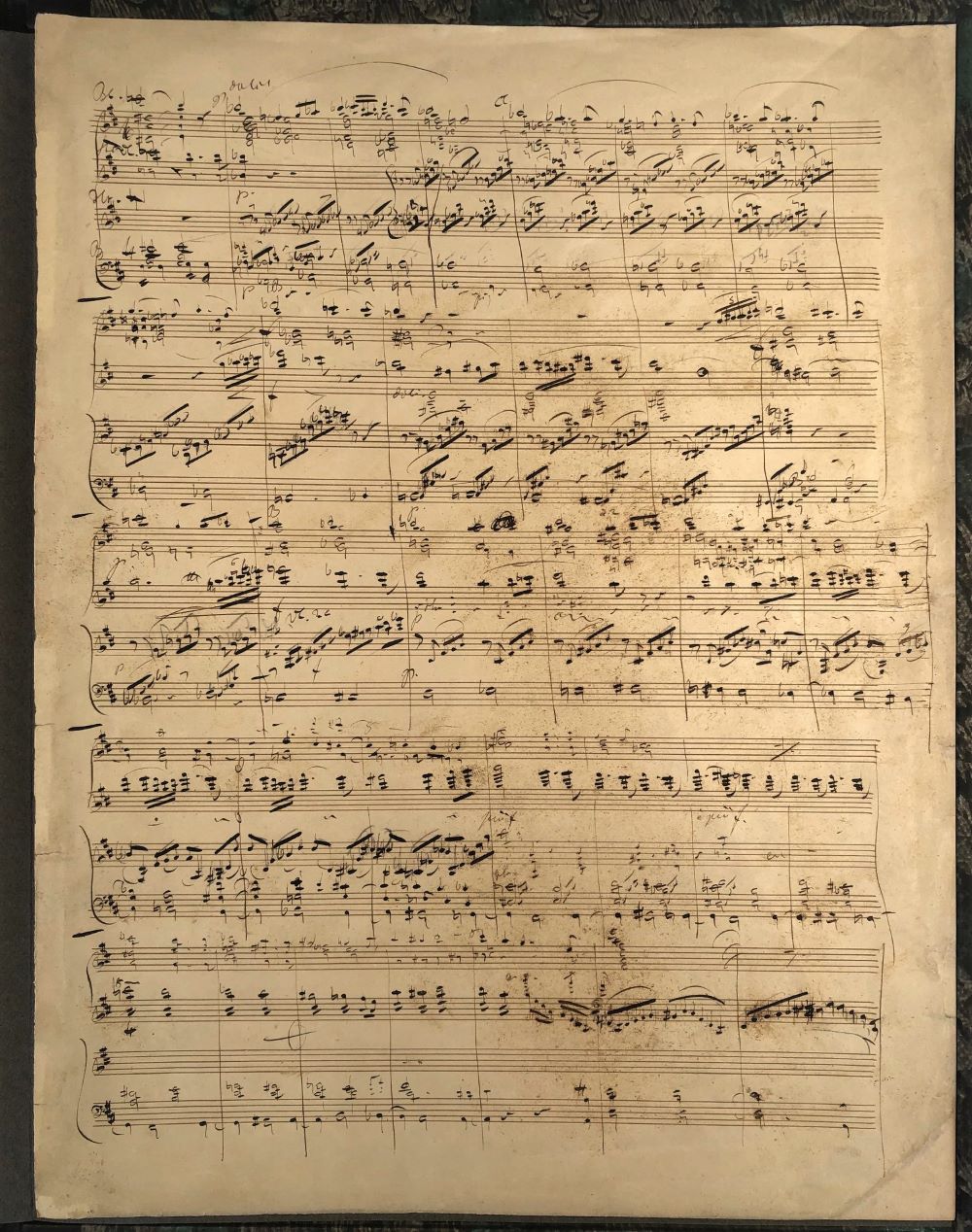WAGNER, Richard [1813-1883]: Autograph music manuscript for the overture of the Flying Dutchman [Paris, Januar 1860]. Folio. 2 pp, 20 staves, 53 bars, 32.5 x 24.9 cm. Ink and pencil - Tinte und Bleistift. Lightly browned with small marginal damages professionally restored. In half-leather folder with gold-stamped title label - Leicht gebräunt mit kleinen fachgerecht restaurierten Randschäden. In Halbledermappe mit goldgeprägten Titelschildchen.
Artikelnummer: 28596
125000,00 €
Steuerbetrag
Standardisierter Preis / COM_VIRTUEMART_UNIT_SYMBOL_:
-
THE FINAL VERSION OF THE MONUMENTAL ENDING OF THE FLYING DUTCHMAN OUVERTURE. Splendid autograph of the last 53 bars of the particell of the new version of the ending of the overture "Der fliegende Holländer" WWV 63. Wagner wrote a new ending for the Holländer Overture in Paris until January 19, 1860 and worked out the fullscore. According to the Wagner-Werkverzeichnis (Mainz 1986, p. 231, VIII a), the autograph is a lost draft of the last 53 bars of the overture. The premiere of the Flying Dutchman had taken place in Dresden on January 2, 1843. After a correction of the end of the overture already made in April 1852, Wagner revised the last 53 bars of the prelude for three concert performances in Paris (January 25 and February 1 and 3, 1860), which are written down in the autograph as a precisely executed particell in four systems each. Wagner had first created, in some places still recognizable, a concept in pencil, which he then overwrote in ink and thus became the fair copy almost without corrections. This third and final ending of the overture represents the final version. On April 10, 1860, Wagner wrote to Matthilde Wesendonk: "I now realize ... that when I wrote Tannhäuser, I was not yet able to do anything like what is necessary here: it required a far greater mastery, which I have only now gained: Now that I have written Isolde's last transfiguration, I could only find the right finale to the Flying Dutchman Overture, as well as - the horror of this Venusberg. One becomes all-powerful when one only plays with the world." At the end of the manuscript, a total of nine bars of indeterminable sketches are noted on two lines. DIE ENDFASSUNG DES MONUMENTALEN SCHLUSSES DER OUVERTÜRE Prachtvolles Autograph der letzten 53 Takte des Particell der Neufassung des Schlusses der Ouvertüre "Der fliegende Holländer" WWV 63. Wagner schrieb bis zum 19. Januar 1860 in Paris einen neuen Schluss für die Holländer Overtüre und arbeitete die Partitur aus. Bei dem Autograph handelt es sich nach dem Wagner-Werkverzeichnis (Mainz 1986, S. 231, VIII a) um einen verschollenen Entwurf der letzten 53 Takte der Ouvertüre. Die Uraufführung des Fliegenden Holländer hatte am 2. Januar 1843 in Dresden stattgefunden. Nach einer im April 1852 bereits erfolgten Korrektur des Schlusses der Ouvertüre revidierte Wagner die letzten 53 Takte des Vorspiels für drei Konzertaufführungen in Paris (25.Januar und 1. und 3. Februar 1860), die dem Autograph als exakt ausgeführtes Particell in jeweils vier Systemen niedergeschrieben sind. Wagner hatte zunächst, an einigen Stellen noch erkennbar, ein Konzept in Bleistift erstellt, das er dann mit Tinte überschrieben hat und damit fast ohne Korrrekturen zur Reinschrift wurde. Dieser dritte und letzte Schluss der Ouvertüre stellt die endgültige Fassung dar. Am 10. April 1860 schrieb Wagner an Matthilde Wesendonk: "Ich erkenne nun ..., dass ich damals als ich den Tannhäuser schrieb, so etwas, wie es hier nöthig ist, noch nicht machen konnte: dazu gehörte eine bei Weitem grössere Meisterschaft, die ich erst jetzt gewonnen habe: Jetzt, wo ich Isolde's letzte Verklärung geschrieben, konnte ich sowohl erst den rechten Schuss zur Fliegenden Holländer- Ouvertüre, als auch - das Grauen dieses Venusberges finden. Man wird eben allmächtig, wenn man mit der Welt nur noch spielt." Am Schluss des Manuskripts sind auf zwei Zeilen insgesamt neun Takte nicht näher bestimmbarer Skizzen notiert.



